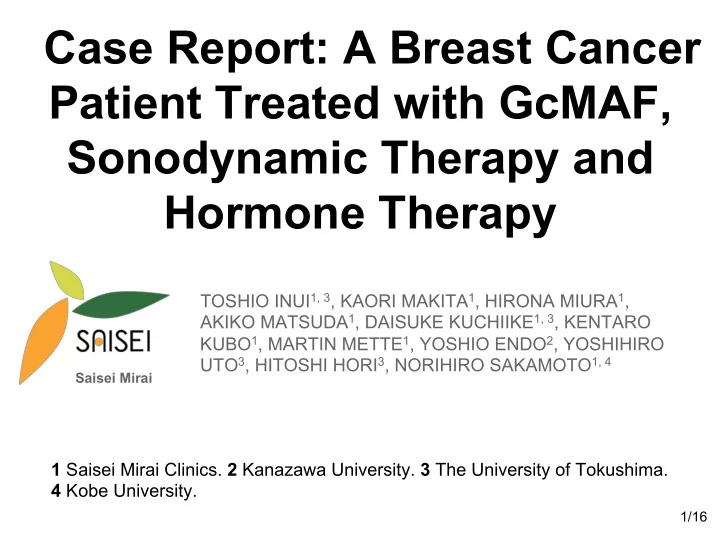

Case Report: A Breast Cancer Patient Treated with GcMAF, Sonodynamic Therapy and Hormone Therapy TOSHIO INUI 1, 3 , KAORI MAKITA 1 , HIRONA MIURA 1 , AKIKO MATSUDA 1 , DAISUKE KUCHIIKE 1, 3 , KENTARO KUBO 1 , MARTIN METTE 1 , YOSHIO ENDO 2 , YOSHIHIRO UTO 3 , HITOSHI HORI 3 , NORIHIRO SAKAMOTO 1, 4 Saisei Mirai 1 Saisei Mirai Clinics. 2 Kanazawa University. 3 The University of Tokushima. 4 Kobe University. 1/16
GcMAF timeline 1991 Dr Yamamoto developed GcMAF 1992 Dr Yamamoto visited Dr Hori at Tokushima University GcMAF research started at Tokushima University 1998 Dr Uto joined Dr Hori’s GcMAF research team 2002 First research papers published on GcMAF in the journals Biotherapy and Comparative Biochemistry & Physiology 2010 Tokushima University began collaborating with Saisei Mirai to develop Second Generation High Dose GcMAF 2011 Second Generation GcMAF produced in our Cell Processing Center (CPC) for patients. Start of clinical use. 2013 Two research papers published in Anticancer Research by Saisei Mirai & Tokushima University 2013 Over 1000 patients treated with Saisei Mirai GcMAF 2/16
Comparison between 1st Generation and 2nd Generation GcMAF First Generation GcMAF ● Developed by Dr Yamamoto in 1991 ● Low concentration (100 ng/0.25 ml, 1 dose) ● Low stability at room temperature ● 25-(OH) Vitamin D3 Affinity Column Second Generation GcMAF ● Developed by the University of Tokushima and Saisei Mirai in 2011 ● High concentration (1500 ng/0.5 ml, 1 dose) ● Significantly higher stability and macrophage activating activity ● New patent pending production process 3/16
GcMAF production in vivo B cell membranous B cells β -galactosidase Gc macrophage Glycoprotein activating factor (Gc Protein) (GcMAF) sialidase T cells Biological activity of GcMAF • increased phagocytic activity • superoxide radical generation • anti-angiogenic effect • anti-tumor effect Conversion of vitamin D3 binding protein (group-specific component) to a macrophage activating factor by the stepwise action of beta-galactosidase of B cells and sialidase of T cells. Yamamoto N, Kumashiro R. J Immunol. 1993 Sep 1;151(5):2794-2802. 4/16
Macrophage phagocytic activity assay of 2nd generation GcMAF • Using mouse macrophages and sheep red blood cells • Red blood cells (white) are opsonized which marks them for ingestion and destruction by activated macrophages, seen as white cells in the purple areas • Calculate the Phagocytosis (ingestion) Index (PI) to determine the level of activity Stability of 2nd Generation GcMAF • 4 ºC > 1 year • 20 ºC 4 weeks • 40 ºC 1 week 5/16
Sensitizers for SDT Modified Tin Chlorin e6 ● Compound made from chlorophyll a in chlorella ● Sensitive to ultrasound and specific wavelengths of light 5-aminolevulinic acid (5-ALA) Chlorophyll ● Natural amino acid found in all animals and plants ● Used to visualize cancer tissue in neurosurgical procedures ● Sensitive to ultrasound and specific wavelengths of light 6/16
Mechanism of Sonodynamic Therapy (SDT) ● Ultrasound is physical energy ○ Sonoluminescence ○ Cavitation ○ Ultrasonic microstreaming ○ Sonoporation ● Energy causes activation of sonosensitizer ● Produces singlet oxygen and free radical oxygen in cancer cells ● Causes coagulative necrosis (cancer cell death) Mechanism of action - SDT + GcMAF DC Cells GcMAF Activated macrophages Killer T-cells Cancer cell death 7/16 (Necrosis)
Sonodynamic Therapy (SDT) Application of gel Application of ultrasound to tumor area 8/16
Breast cancer patient: Medical history • 55-year-old female with recurrent breast cancer • Sep 2009 - Lumpectomy of left breast tumor with skin invasion • Patient refused to receive any further standard treatment after the operation • Oct 2011 - Patient noticed right axillary tumor. Currently no treatments being undertaken • The tumor kept growing and tumor markers were increasing • Jul 2012 - Needle aspiration biopsy was done to confirm the recurrence of the tumor • Jul 2012 - Patient started receiving Hyperthermia (total 24 times with Thermotron RF-8) and i.v. high dose vitamin C (total 10 times) • Jun 2013 - Patient presented in my clinic 9/16
Symptoms (at presentation) • Cough • Back pain • Severe swelling of the right arm (edema) Pathological findings • Invasive Ductal Carcinoma (IDC), N0 (no nodes are involved), Margin (–), Grade 3, ER+, PR+, Her2+ 10/16
Treatment Overview • Second Generation High Dose GcMAF o 0.5 ml, 2 times weekly (i.m.) o Total 21 times • Sensitizers for SDT o Modified Tin Chlorin e6, 25 mg (i.v.) o 5-aminolevulinic acid (5-ALA), 10 mg/kg BW (oral) o Total 19 treatment days of SDT 12-Jun-2013 to 30- Sep-2013 • Aromatase Inhibitor o Aromasin, 25 mg/day (oral) 11/16
PET CT and CT showing disappearance of lung pleural effusion PET CT 6-JUN-2013 CT 9-SEP-2013 Lung pleural effusion and nodular shadow Lung pleural effusion and nodular shadow before treatment with SDT. disappeared after treatment with SDT. 12/16
Change in monocyte percentage and monocyte number during GcMAF therapy A patient’s monocytes will generally rise in the early stages of High Dose GcMAF and indicates a good response to treatment. 13/16
Normal range NCC-ST-439 < 4.5 U/ml * Normal range < 27.0 U/ml * for 50 years of age or older Normal range < 4.5 ng/ml 14/16
Results • Improvement of symptoms such as cough, back pain and rt. hand edema • Remarkable improvement of tumor markers • Decreased size of the axillary tumor • No serious side effects from the treatments 15/16
Conclusion and perspective • We showed the case report of a terminal breast cancer patient having had good effects from SDT, GcMAF and hormonal therapy • We are expecting good outcomes from the next PET CT scan • It suggests SDT and GcMAF can be used with standard treatments to get better outcomes for cancer patients • We are planning to further refine and improve our protocols with SDT and GcMAF 16/16 Saisei Mirai Cell Processing Center (CPC)
Recommend
More recommend